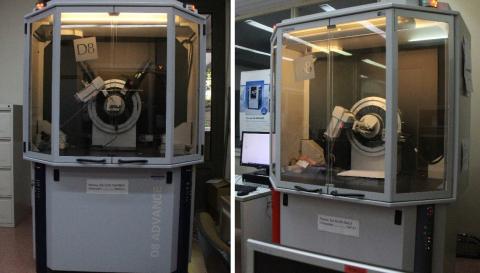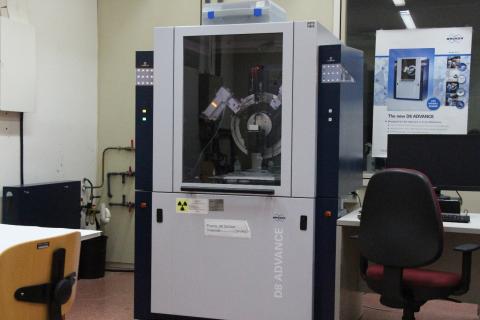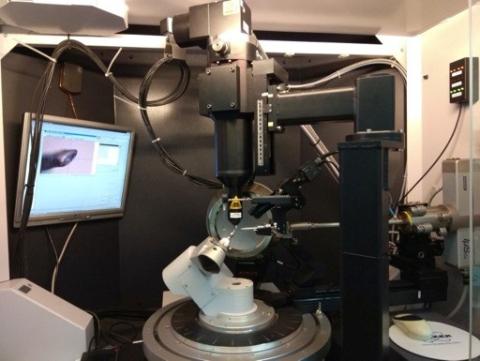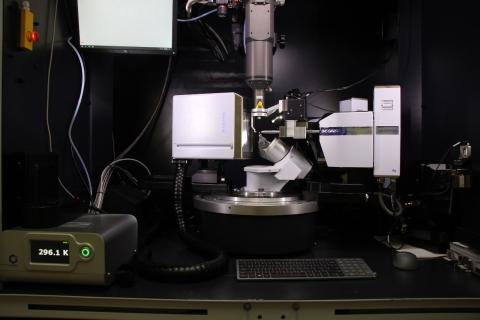Difracción de Rayos X
Responsable científico
Dr. Felipe Gándara Barragán (E. Científico titular)
Personal técnico
Dra. Fátima Esteban Betegón (E. Técnico Especializado de Organismos Públicos de Investigación)
Dr. Raluca Loredana Vasile (Técnico PTA)
Contacto
+34 913349000 ext. 437023 / 437204
+34 917166025 (numero directo)
Localización
Difractómetros de polvo: laboratorio doble 023-025
Difractómetros de monocristal: laboratorios 049 y 051
ICMM-CSIC, C/ de Sor Juana Inés de la Cruz, 3 28049 Madrid, España
El Laboratorio de Difracción de Rayos X del Instituto de Ciencia de Materiales de Madrid ofrece acceso a equipos para la caracterización cristalográfica mediante diferentes técnicas de difracción de rayos X tanto al personal del ICMM como a usuarios externos.
Equipamiento
El Laboratorio de Difracción de Rayos X del Instituto de Ciencia de Materiales de Madrid ofrece acceso a equipos para la caracterización cristalográfica mediante diferentes técnicas de difracción de rayos X tanto al personal del ICMM como a usuarios externos.
Nuestro laboratorio está equipado con:
1. Tres difractómetros de polvo:


Dos difractómetros de monocristal


Extras: 1) módulo de refrigeración de muestras con compresor de gas capaz de enfriar hasta 90k con gas nitrógeno y hasta 30 K con gas helio (modelo N-Helix con controlador de la serie 800 de OXFORD CRYOSYSTEM) y 2) célula para mediciones de alta presión.
Estos difractómetros permiten identificar las fases cristalinas presentes en muestras sólidas y analizar determinados parámetros cristalográficos.
Además el servicio de difracción pone a disposición de sus grupos usuarios el acceso a bases de datos cristalográficas, tales como CSD o ICSD. Recientemente el servicio ha adquirido nuevas licencias de programas de análisis de datos de difracción, tales como EVA, TOPAS, o LEPTOS. Los equipos informáticos del servicio están a disposición de las personas usuarias, tanto para control de equipos como de análisis y tratamiento de datos.
Tipos de análisis:
Análisis de difracción de rayos X en polvo:
- Geometría de reflexión en cualquiera de los tres difractómetros de polvo. Las muestras en forma de polvo se preparan sobre una superficie plana y se recogen barridos Theta/2theta en el rango seleccionado, entre 2 = 2.5 y 120.
- Microdifracción de rayos X (µDRX): permite mediciones precisas sobre áreas muy pequeñas, facilitando el análisis en muestra pequeña o no homogénea con composición variable, tensión de red u orientación preferencial de los cristalitos. La zona de análisis se selecciona mediante una cámara de vídeo con ayuda de un puntero láser que, junto con colimadores de diferentes tamaños, produce un haz de rayos X incidente con diámetros de 0,5, 0,3 o 0,1 mm. Además, una platina/mesa de muestra motorizada en xyz permite escanear diferentes áreas de las muestras.
- Geometría de transmisión: Las muestras se preparan en capilares de vidrio sellados, y los patrones de difracción se recogen con un detector bidimensional, con la radiación seleccionada de Cu, Mo o Ag procedente de una fuente microfocalizada. Útil para el análisis de muestras sensibles al ambiente, o cuando sólo se dispone de una pequeña cantidad.
Análisis de difracción de rayos x en muestras monocristalinas:
- Análisis estructural completo, con longitud de onda seleccionada de radiación de Cu, Mo o Ag. Las mediciones incluyen la adquisición y tratamiento de los datos. La recogida de datos puede realizarse a la temperatura seleccionada entre temperatura ambiente y 30 K.
Tipo de muestras analizadas
Muestras en polvo: las muestras se presentan en forma de polvo, cuya cantidad depende de la naturaleza de la muestra, normalmente entre 20 y 200 mg. Las muestras pueden prepararse en el laboratorio de difracción. Para mediciones en geometría de transmisión, las muestras se preparan dentro de capilares de vidrio transparente a los rayos X con diámetros entre 0,1 mm y 1,0 mm.
Monocristales: Los cristales se seleccionan con el microscopio óptico disponible. Cristales con tamaños desde 10 µm (dependiendo de la naturaleza y composición de la muestra).
Protocolos
El servicio posee un calendario periódico para realizar verificaciones con muestras patrón en los equipos, que permite mejorar la fiabilidad de los datos obtenidos, y conocer el estado de los equipos. Estas medidas de control también se hacen tras una modificación de la configuración óptica del difractómetro, o cualquier otra intervención, lo que permite estudiar si ha habido alguna repercusión en el resultado final.
ICMM
Sor Juana Ines de la Cruz, 3
Cantoblanco, 28049
Madrid, España
Teléfono: (+34) 91 334 90 00
Email: @email
Comunicación: @email

Contacto | Accesibilidad | Aviso legal | Política de Cookies | Protección de datos




